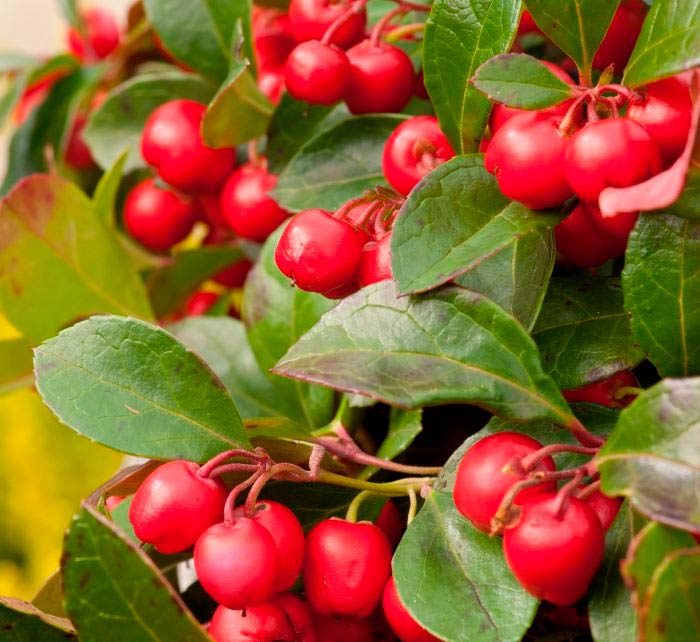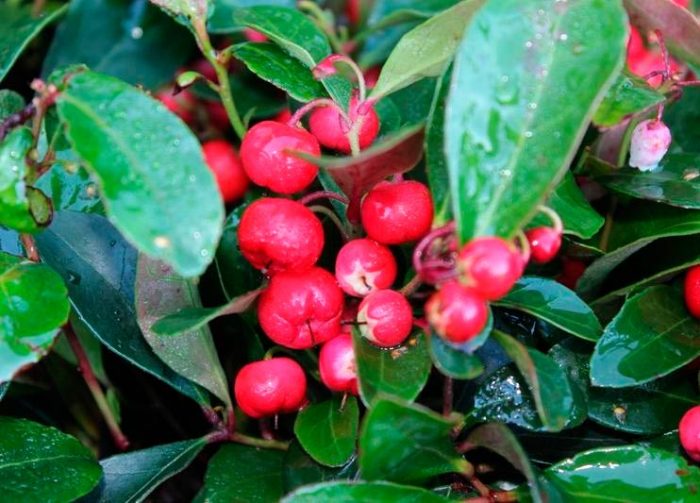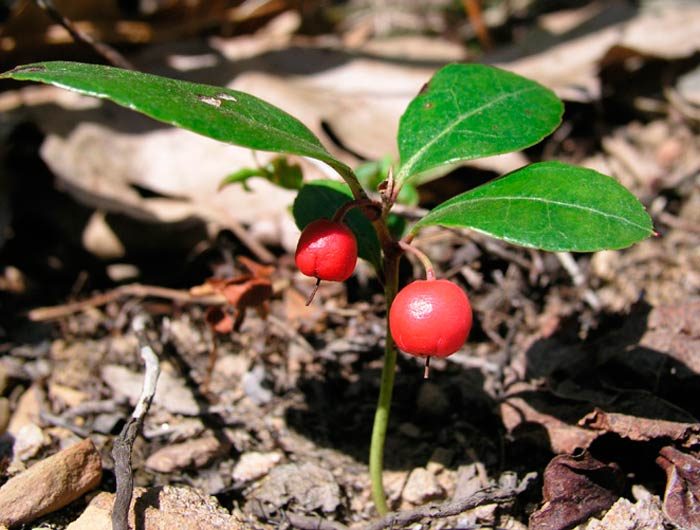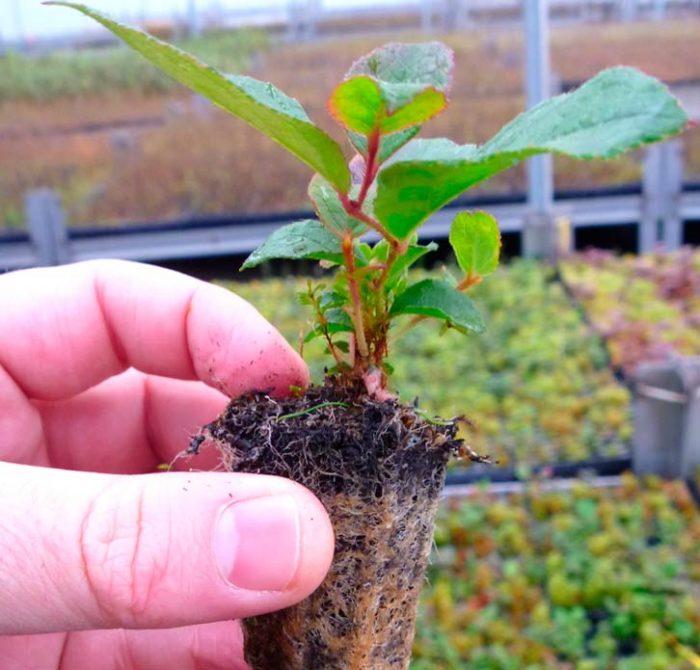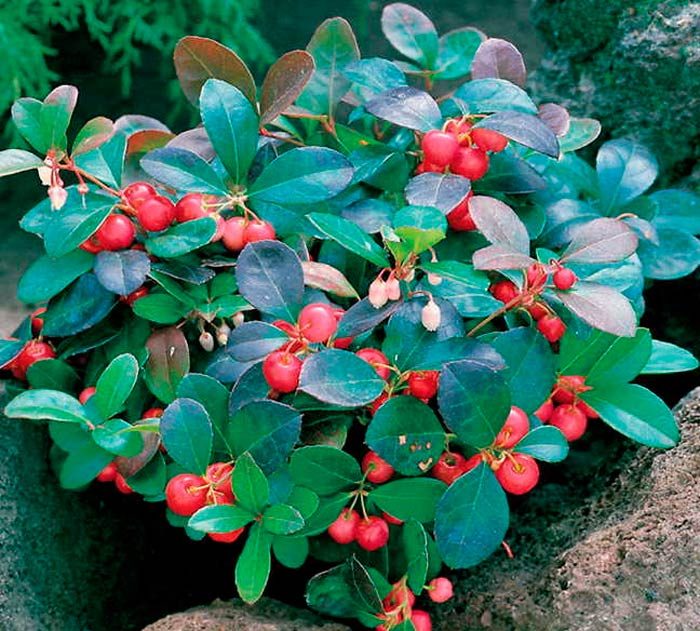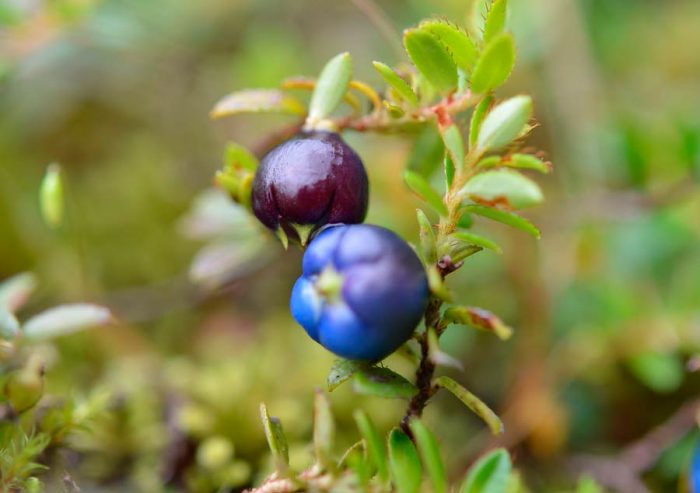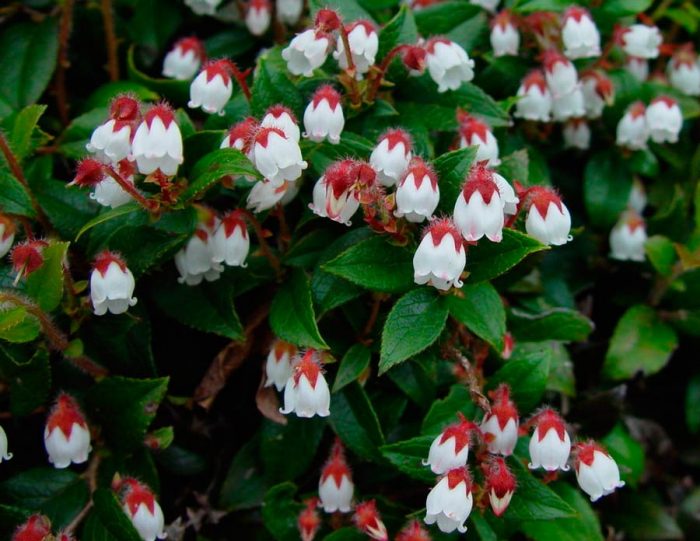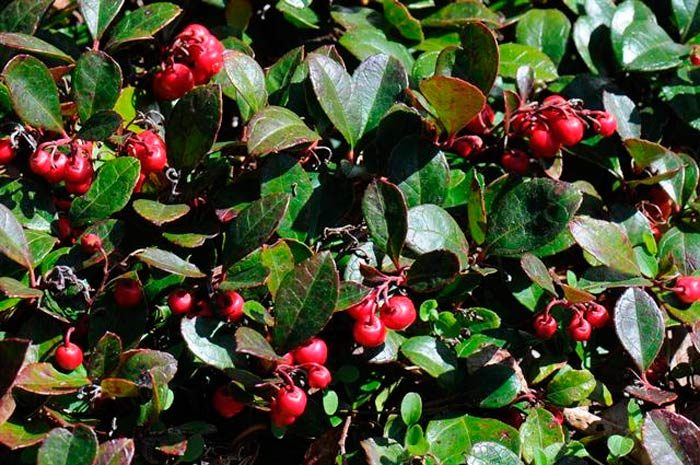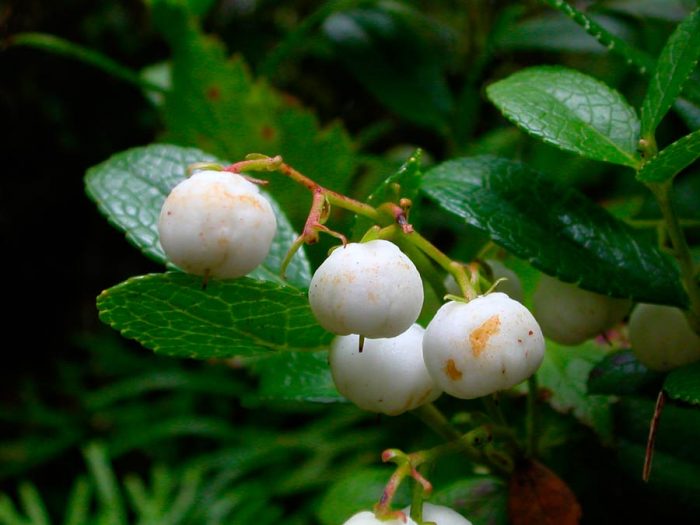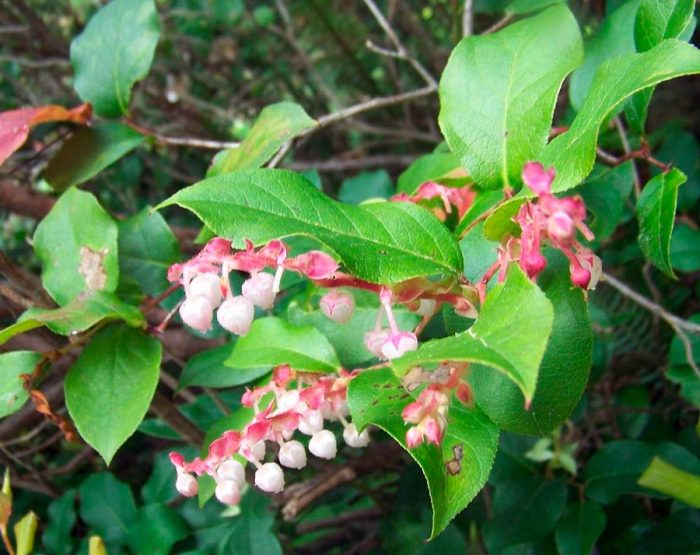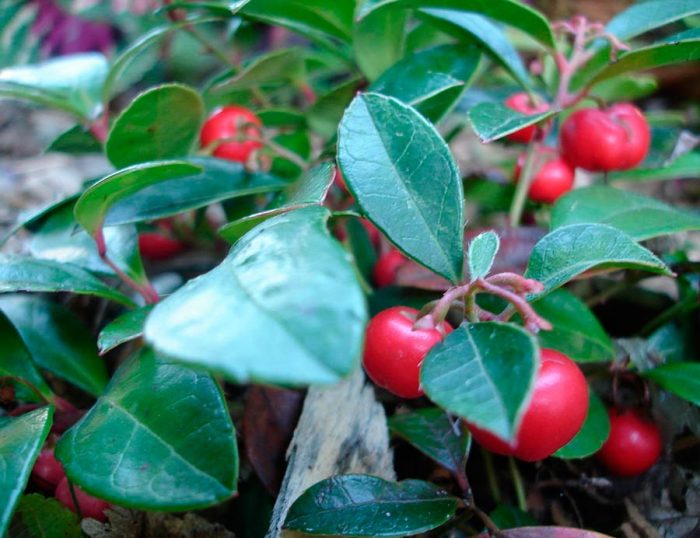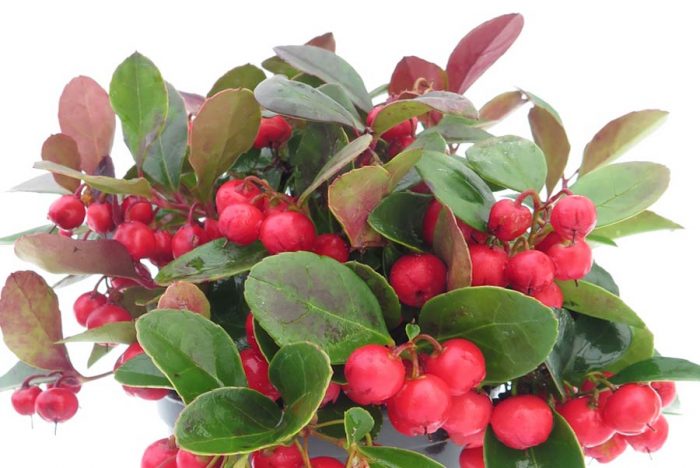The Gaultheria plant, also called Gautieria, or Gaultheria, or Goltheria, is a member of the Heather family. This genus unites about 80 species. In nature, they can be found in Asia, New Zealand, South and North America, and also Australia. This genus was named after Jean-François Gaultier, who was one of the first researchers of the flora of Canada, as well as a French physician and botanist. Only a part of the species is cultivated by gardeners as ornamental plants.
Content
Features of haulteria
Gauntlets grown in mid-latitudes are not very large evergreen shrubs with high frost resistance and compact branches. Small leathery shiny dark green leaf plates are entire. In late spring or early summer, pinkish-white flowers are formed that look similar to lilies of the valley; they can be collected in low-flowered inflorescences or be single. They have an exquisite scent and thin delicate petals. The inedible fruit is a berry similar to a cranberry, it reaches up to 10 mm in diameter and has a rich red, white or dark blue color. The fruits look very impressive against the background of the leaves and remain on the branches for several months. This plant is slow-growing. If the conditions are suitable, then this shrub in the same place can be grown for about 50 years.
Growing haulteria from seeds
Sowing
Seed material from the haulteria needs a three-month stratification before sowing. The seeds must be combined with moistened moss, then the mixture is poured into a glass container, which is tightly closed and placed on a refrigerator shelf designed for vegetables, while the air temperature should be 2–4 degrees. Sowing the prepared seeds is carried out in boxes filled with high-moor peat, while they do not need to be sealed. Then the container is removed to a well-lit and warm place. The first seedlings should appear after 14–20 days. The picking of plants should be carried out after they have formed 2 pairs of true leaf plates.It is necessary to plant 1 or 2 plants in individual pots, then they are grown in a greenhouse or in indoor conditions for two or three years, after which they must be hardened and planted in the garden.
Landing in open ground
For growing this plant, you can choose a well-lit area, either in the shade or slightly shaded. The soil should be loose peaty and acidic (pH not more than 5.0). The soil should not contain lime. If the land on the site is excessively heavy, then a substrate must be prepared to fill the planting holes; for this, semi-rotted coniferous litter, high-moor peat and coarse sand (2: 3: 1) are combined. The depth of the planting holes should be from 0.3 to 0.4 m, and the distance between them should be 0.2–0.4 m, while it should be borne in mind that the denser the soil, the smaller the distance between the bushes should be. At the bottom of the pit, you need to make a good drainage layer with a thickness of 10 to 15 centimeters, for this they take pebbles or broken brick. During planting, the root collar must be placed at the same level with the surface of the site, or it can be deepened, but not more than 15 mm. When the hole is filled up, the surface of the trunk circle must be compacted, and the plant must be watered.
Caring for the gault
At the beginning of spring, before the growth of the stems begins, the pruning is carried out, which helps to stimulate active branching. During pruning, it is also necessary to remove injured, dried out and diseased stems and branches. At the same time, the shrub is fed, for this, 150 grams of Nitroammofoski and 100 grams of Kemira-wagon per 1 square meter must be added to its near-stem circle.
Watering is carried out 1 time in 2 weeks, while 0.5 buckets of water are poured under one bush. During a prolonged drought, the frequency of watering is increased to 1 time in 7 days, while this procedure is carried out in the evening. When the rain passes or the bush is watered, the surface of the soil near the bush must be carefully loosened, while remembering that the roots are placed very close to the surface of the site. While loosening, you should pull out all the weeds that grow near it. In order to significantly reduce the number of watering, the surface of the trunk circle must be covered with a layer of mulch (peat or wood chips), while its thickness should be from 8 to 10 centimeters.
In June, it is necessary to apply mineral fertilizer to the soil of the trunk circle, which should not contain nitrogen. For wintering, adult bushes do not need to be covered. However, young shrubs must be protected from frost, for this the trunk circle is covered with a layer of mulch (dried foliage or peat), the thickness of which should be at least 8-10 centimeters, and the plant itself is covered with spruce branches. In springtime, the shelter must be removed.
Types and varieties of haulteria with photos and names
There are many types of gardeners in nature, but only a small part is cultivated by gardeners. A description of the most popular species and varieties will be given below.
Hairy gaultheria (Gaultheria trichophylla), or hairy gault
This plant is native to East Asia (Himalayas and China). The height of this shrub is about 10 centimeters. The length of the greenish-gray leaf plates is from 0.5 to 1 cm, they have an oblong or elliptical shape. Pink drooping bell-shaped flowers reach 0.4 cm in length. Fruit color is blue. This species began to be cultivated in Europe since 1897.
Gaultheria ovalifolia
The homeland of this species is the west coast of the United States of America. The shrub reaches a height of about 0.3 m. The length of the leaf plates is about 35 mm, and the length of white flowers is up to 5 mm. The color of the fruits is deep red, they reach 10 mm in diameter. This species has been cultivated since 1890.
Gaultheria humifusa
This species comes from western North America. The height of the bush is about 10 centimeters.Almost round or ovoid leaf plates are slightly serrated along the edge, and their length is about 20 mm. Single axillary bell-shaped flowers reach up to 0.5 cm in length. Fruits are 0.7 cm across, and they are colored scarlet-red. This shrub has been cultivated since 1830.
Gaultheria adenothrix
This species comes from the Japanese islands of Honshu, Shikoku and Hokkaido. In nature, he prefers to grow in coniferous forests and on rocks. The height of the bush is about 0.3 m. Leathery oval-shaped leaf plates serrated along the edge on the front surface are bare, their width is about 20 mm, and their length is up to 30 mm. Bell-shaped drooping flowers can be single or collected in 2-3 pieces at the tops of the stems, their outer surface is white, and the inner one is pale pink. The length of the flowers is about 0.8 cm. On the surface of the red fruits, there are many small glands.
Gaultheria miqueliana
In the wild, this species grows in groups and is found on the territory of the Kuriles, Japan and Sakhalin. The height of such an erect shrub is about 0.25 m. The branches are erect, and the rhizomes are creeping. Dense leaf plates are colored dark green; during flowering, few-flowered brushes are formed. The fruits reach about 0.8 cm in diameter, and outwardly they are similar to the berries of a snowberry. Such a frost-resistant species is quite difficult to grow in your garden.
Gaultheria shallon
This species is most popular with gardeners, and it comes from North America. The height of the bush is about 50 cm. The stems are straight and ascending. The alternately arranged ovoid leaf plates reach about 12 centimeters in length. At the tops of the stems there are panicles consisting of white or pink jug-like flowers, while they reach about 10 mm in diameter. The berries are purple at first, but after a while they turn black, their diameter is about 10 mm. This species has been cultivated since 1826.
Gaultheria procumbens
This species is native to the eastern part of North America. In nature, he prefers to grow in mixed forests and among tall shrubs. The height of the creeping stems is about 15 centimeters, they form a bush that reaches about 0.4 m in diameter. Glossy, almost round leaf plates of a rich green color in length reach about 40 mm. Water-lily drooping white flowers are solitary. Inedible berries reach about 10 mm in diameter, they have a scarlet-red color. Such a plant has been cultivated since 1762. Each of the parts of this shrub has a specific aroma. Gardeners cultivate it as a ground cover plant.
Properties of haulteria: harm and benefit
Useful properties of haulteria
Gaulteria is not only an ornamental plant, but also has medicinal properties. It is distinguished by anti-inflammatory, stimulating, carminative, antirheumatic, diuretic, resorption and analgesic effects. Such a plant contains organic acids, formaldehyde, gulterilin, arbutin and tannins, while the main biological active substance is methyl salicylate.
For a long time, the foliage of such a shrub has been used to make tea, which helped to eliminate headaches and get rid of throat ailments. They can also be chewed raw if you need to quickly relieve fatigue.
In traditional medicine, oil is used, which is made from the foliage and young stems of the haulteria. Also on its basis, such products are made as: Naftalgin, Kapsin, Sanitas and Saliniment. They are used externally for painful sensations in the joints as an anti-inflammatory and analgesic drug. The oil made from the lying gultery has a warming effect, in this regard, it is rubbed into painful areas of the body or into overstrained muscles, and it is also used externally for the treatment of skin inflammations, lumbago, neuralgia, rheumatism, fibrositis and cellulite. The smell of such oil improves mood, it invigorates, relieves fatigue and stress, and also refreshes the air in the room.
Contraindications
Products made on the basis of haulteria cannot be used by pregnant and breastfeeding women, and they are also prohibited from taking with aspirin. And also experts strongly advise against taking such funds to children under 6 years old, as well as to people who have an individual intolerance to haulteria. If your skin is very sensitive, then you need to be extremely careful when applying gultury oil on it. The composition of such a plant includes poison, in this regard, it is necessary to take funds made on its basis only as directed by a qualified specialist and strictly adhere to the dosage recommended by him.

